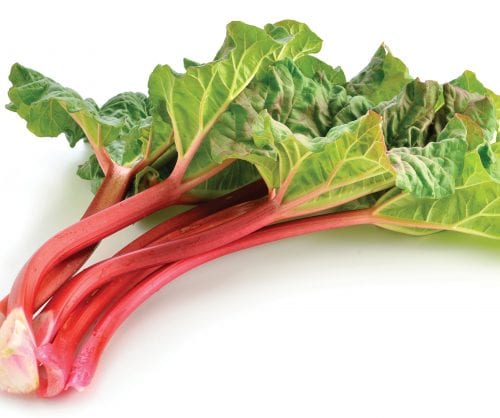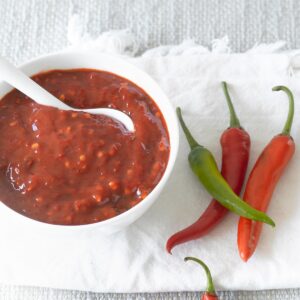
Rhubarb
Just a half-cup serve of stewed rhubarb gives you 3g of fibre (10-12 per cent of your daily requirement) and 120mg calcium (12 per cent of your daily requirement).
Rhubarb also contains a naturally occurring organic acid called oxalic acid (or oxalate). Oxalates can combine with minerals, such as calcium, to form crystals. The calcium is then taken out of the body, and can’t be absorbed. The good news is that cooking the rhubarb can reduce the effect of the oxalates.
The stems of rhubarb plants can be stewed and used in baking instead of, or in addition to, apple. It is also tasty as a side to meat dishes or as a topper for yoghurt and cereal. Be careful of what you add when you cook with it – cream, custard and sugar make it a treat food.
Did you know?
- Rhubarb is a vegetable
- Leaves on a rhubarb plant are poisonous.
Recipe ideas
Rhubarb and date muffins
Rhubarb yoghurt puds
Grapefruit
Grapefruit can be eaten on their own or added to spring salads for extra zing. The fruit is delicious squeezed fresh as a tart juice, or made into a marmalade. One grapefruit gives you 94mg of vitamin C, around half the suggested daily target for good health. Pink or red grapefruit contains lycopene and flavonoids – nutrients that may reduce the risk of heart attacks.
Each grapefruit contains around 15 per cent of our adequate intake of potassium (about 540mg). Getting enough potassium through fruit and vegetables is a great way to help lower blood pressure and protect your bones. Grapefruit interact with some medications, so check with your pharmacist or doctor before eating this season.
Did you know?
Grapefruit were introduced to New Zealand from Australia in the mid-1800s.
Recipe idea
Orange and grapefruit salad with pistachios
Telegraph cucumber
Telegraph cucumbers have soft skin and don’t usually need peeling. Leaving the skin on provides more fibre.
Cucumbers are low in energy and carbohydrates. They’re often a key ingredient in salads and peeling them into ribbons adds texture. Cut cucumber into sticks and serve with hummus for a crunchy and quick afternoon snack.
Growing facts
- Cucumbers grow quickly and are a great first garden project for children
- One single plant can grow up to 10-15 cucumbers – be sure to pick regularly to encourage growth
- Plant from August onwards, or grow year-round in a greenhouse.
Recipe ideas
Salmon, cucumber and coriander noodle salad
Carrot and cucumber raita
Fresh this month
(Harvested in New Zealand gardens in October)
Vegetables: Broccoli, cabbages, celeriac, chilli, cauliflower, courgettes, leeks, lettuce, mushrooms, onions, parsnips, potatoes (new season), pumpkin, radishes, rocket, silver beet, snow peas, spinach, spring carrots, spring onions, swedes, watercress
Herbs: Chives, coriander, dill, marjoram, mint, oregano, parsley, rosemary, sage, thyme
Fruit: Avocado, kiwifruit, lemons, limes, navel oranges, tangelos
Article sources and references
- Arab S & Steck S 2000. Lycopene and cardiovascular disease. American Journal of Clinical Nutrition 71:S1691-5https://www.ncbi.nlm.nih.gov/pubmed/10837319
- Barot M et al. 2015. Lithiasis: The causative sources are ureates and oxalates. World Journal of Pharmacy and Pharmaceutical Sciences 4:542-65file:///C:/Users/christine.fairgray/Downloads/article_wjpps_1438355283.pdf
- National Health and Medical Research Council, Australian Government Department of Health and Ageing, New Zealand Ministry of Health. 2006. Nutrient Reference Values for Australia and New Zealand: Version 1.1 Updated March 2017. Canberra: National Health and Medical Research Councihttp://www.moh.govt.nz/notebook/nbbooks.nsf/0/FD14C5E898B74265CC2574BE007DACF6/$file/n35.pdf
- Prasad R & Y.S.Shivay YS. 2016. Plant foods, beverages and kidney stone disease – an overview. Insights in Nutrition and Dietetics.1:1-5
- Testai L & Calderone V. 2017. Nutraceutical value of citrus flavanones and their implications in cardiovascular disease. Nutrients 9:502https://www.ncbi.nlm.nih.gov/pubmed/28509871
- Weaver M. 2013. Potassium and health. Advances in Nutrition. 4:S368-377https://www.ncbi.nlm.nih.gov/pubmed/23674806
www.healthyfood.com










